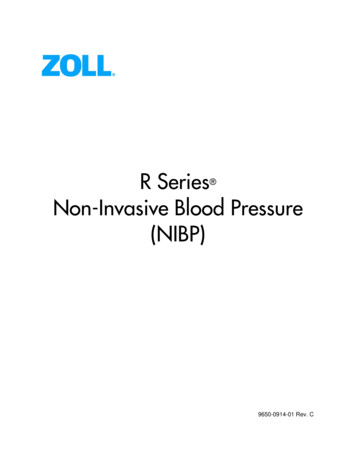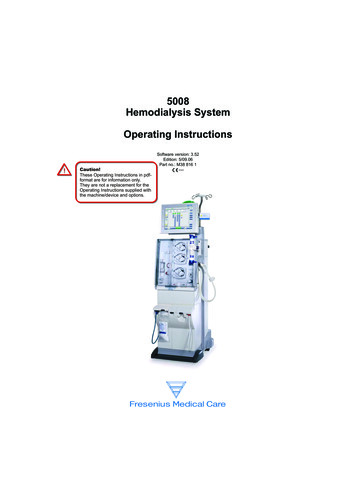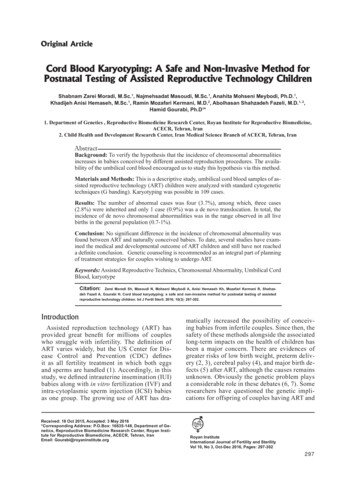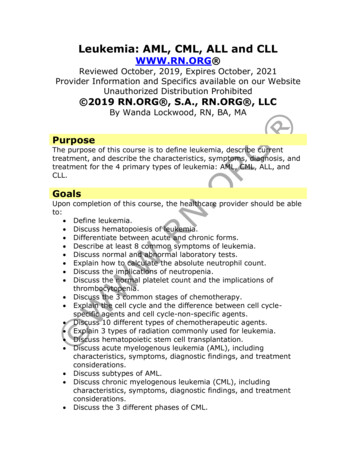
Transcription
R SeriesNon-Invasive Blood Pressure(NIBP) 9650-0914-01 Rev. C
R SERIES — NON-INVASIVE BLOOD PRESSURE (NIBP) OPTION INSERTThe issue date for the R Series Non-Invasive Blood Pressure guide(REF 9650-0914-01 Rev. C) is January, 2018.Copyright 2018 by ZOLL Medical Corporation. All rights reserved. ZOLL and R Seriesare trademarks or registered trademarks of ZOLL Medical Corporation.SunTech Advantage is a registered trademark of SunTech Medical Group.All other trademarks and registered trademarks are property of their respective owners.iiwww.zoll.com9650-0914-01 Rev. C
Non-Invasive Blood Pressure Monitoring (NIBP) Indication of UseNon-Invasive Blood Pressure Monitoring (NIBP)Indication of UseThe R Series system is indicated for the non-invasive measurement of arterial blood pressurefor resting patients in critical care and in-hospital transport. The NIBP feature is indicated tomeasure blood pressure for patients from newborn (neonate) to adult.NIBP Contraindications for UseThere are no known contraindications for the use of the NIBP monitor.General InformationFederal (U.S.A.) law restricts this defibrillator to sale by or on the order of a physician.9650-0914-01 Rev. CR Series Non-Invasive Blood Pressure (NIBP)iii
R SERIES — NON-INVASIVE BLOOD PRESSURE (NIBP) OPTION INSERTivwww.zoll.com9650-0914-01 Rev. C
Non-Invasive Blood Pressure (NIBP)Product DescriptionThe Non-Invasive Blood Pressure (NIBP) option on the R Series unit gives you the ability totake a single blood pressure measurement, STAT measurements (automatically repeatedmeasurements over a 5 minute period), or automatic measurements at repeating pre-selectedintervals. The blood pressure information (including the patient’s systolic, diastolic and meanblood pressure values) is shown on the R Series monitor in the NIBP display area, on the leftside of the screen.For R Series BLS/Plus models, the NIBP option can only be used while the unit is in Manualmode.How To Use This ManualThis insert describes how to set up and use the R Series NIBP option. Important safetyinformation relating to the general use of the R Series NIBP option appears in “SafetyConsiderations” on page 2.Before attempting to use the NIBP option, you must read and understand all the informationcontained in the R Series Operator’s Guide, which provides information that operators need forthe safe and effective use and care of the R Series unit.Thoroughly read the Safety Considerations and Warnings sections in both the R SeriesOperator’s Guide and the relevant inserts before operating your R Series product.SunTech CE ContactDirect all cuff, hose, and NIBP questions with regards to the Declaration of Conformity withEuropean Union Directives to the authorized representative for SunTech:SunTech Medical Instruments Ltd.Oakfield Industrial EstateStantom Harcourt RoadEynsham, WitneyOX8 ITSUK9650-0914-01 Rev. C1
R SERIES — NON-INVASIVE BLOOD PRESSURE (NIBP) OPTION INSERTSafety ConsiderationsGeneral NIBP Safety Read the R Series Operator’s Guide and this manual insert before use. Ensure that the R Series NIBP option is operated by qualified personnel only. Consult a physician for the proper interpretation of pressure measurements. Do not use on patients known to be susceptible to bruising. Use caution when using on elderly hypertensive patients, as such patients may be more susceptible to bruising.Route patient hoses carefully to avoid patient entanglement, strangulation or compression ofhose.Do not select a cuff inflation pressure that exceeds the patient’s expected systolic pressureby more than 30-40 mmHg (4.0-5.3 kPa). The factory-installed default adult cuff inflationpressure is 160 mmHg (21.3 kPa) for adult patients, 120 mmHg (16.0 kPa) for pediatricpatients, and 90 mmHg (12.0 kPa) for neonatal patients.Keep patient, hose and cuff as still as possible during measurement. Patient movement orvibrations from outside sources, particularly moving vehicles, can degrade measurementaccuracy.Check patient regularly for signs of skin irritation or impaired circulation in the monitoredlimb.Do not use the NIBP option on a patient when the R Series unit is connected to an ECGsimulator.If an alarm occurs while the audible alarm indicators are disabled, alarms do not sound;rather only the visual alarm indicators are displayed.If the accuracy of measurements is suspect, first check the patient's vital signs by alternatemeans. Then check the cuff, hose and R Series NIBP option for proper functioning.The cuff, hose, and fitting are defibrillation-protected. Using the NIBP option introduces norisk for shock due to defibrillation. The cuff and hose are non-conductive. Using the NIBPoption introduces no risk for burns due to electrosurgery.Cuff safety and effectiveness have not been proven on pregnant women.Do not attach the cuff to a limb being used for IV infusions or any other intravascularaccess, therapy or an arterio-venous (AV) shunt.The cuff inflation can temporarily blockblood flow, potentially causing harm to the patient.Applying the cuff over a wound can cause further injury.For patients that have had a mastectomy, cuff should be applied to opposite arm.Blood pressure measurements can be affected by the position of the patient, physiologiccondition, activity level, improper cuff size/application, environment and use outside of theoperating instructions detailed in this manual.The NIBP module may not operate correctly if used or stored outside the relevanttemperature or humidity ranges described in the specifications on page 28.Cuff and Hose Safety Only use cuffs, hoses, and connectors supplied or specified by ZOLL. Ensure that the hose is not kinked or obstructed before taking measurement.2www.zoll.com9650-0914-01 Rev. C
Cuff and Hose Safety Do not use damaged cuffs, hoses, or connectors. Ensure proper cuff selection and placement to avoid inaccurate measurements or patient injury.Position the cuff so it is level with the heart during measurement.Do not attach the cuff to a limb being used for IV infusion, SpO2 monitoring, or othermonitoring equipment. Cuff inflation might block the infusion, causing harm to the patientor inaccurate SpO2 measurements.Do not repeat NIBP measurements (particularly STAT measurements) at intervals less than3-5 minutes over an extended period of time. Rapidly repeating measurement can impaircirculation in the monitored limb.Do not sterilize or immerse the cuffs or hoses.9650-0914-01 Rev. CR Series Non-Invasive Blood Pressure (NIBP)3
(This page intentionally left blank.)
NIBP Intended UseNIBP Intended UseThe ZOLL R Series NIBP option is intended to be used for the non-invasive measurement ofarterial blood pressure for resting patients in critical care and in-hospital transport.The R Series NIBP option is designed to measure blood pressure for adult patients (21 years ofage and older) and for pediatric patients, as described in the following table:Pediatric SubpopulationApproximate Age RangeNewborn (neonate)Birth to 1 month of ageInfant1 month to 2 years of ageChild2 to 12 years of ageAdolescent12-21 years of ageWhat Can I Do With the NIBP Option?With the NIBP option you can do the following in MONITOR, PACER, or DEFIB (ON forBLS/Plus units, then select Manual) mode: Take a single blood pressure measurement. Take a STAT measurement (as many measurements – up to 10 – as possible within 5minutes). Take repeated measurements at user-programmable intervals. Immediately abort any measurement in progress by pressing one button. Set the cuff inflation pressure to adjust automatically based on the previously measuredsystolic value. Display systolic, diastolic and mean blood pressure on the screen. Configure alarms to go off when the unit detects blood pressure values above or belowuser-programmable limits. Display a history of NIBP measurements taken in the last 4 hours.How Do I Use the NIBP Option?To take safe and accurate blood pressure measurements using the R Series NIBP option, youmust perform the following steps, each of which corresponds to a subsequent section in thisdocument. Read each section carefully before you use the R Series NIBP option.1. Select the proper size cuff.2. Connect the hose to the R Series unit and to the cuff.3. Apply the cuff to the patient.4. Display the NIBP menu.5. Select the correct patient type (if the current setting is not appropriate).6. Set the cuff inflation pressure (if the current setting is not appropriate).7. Configure alarms (if the current settings are not appropriate).8. Take blood pressure measurement(s).9. Read the display.9650-0914-01 Rev. CR Series Non-Invasive Blood Pressure (NIBP)5
R SERIES — NON-INVASIVE BLOOD PRESSURE (NIBP) OPTION INSERTWARNING!Do not use the NIBP option without proper training. Setting initial inflation pressuretoo high can result in serious injury to the patient. Patient movement, very low pulsevolume, or vibration from outside sources can influence the accuracy of blood pressuremeasurements.How Does the NIBP Option Work?The patient blood pressure cuff and hose connect to the R Series unit through the NIBPconnector on the rear panel of the unit. The NIBP button () on the front panel of theR Series allows you to initiate and terminate non-invasive blood pressure measurements, whosevalues display in the NIBP area of the monitor. You can also initiate and terminate Auto orSTAT mode measurements using the softkeys on the NIBP menu.The ZOLL R Series NlBP Option non-invasively measures arterial blood pressure and pulserate in resting adult, neonate and pediatric patients. By incorporating the SunTech MedicalAdvantage OEM BP A R-wave Motion Tolerance Module into the R SeriesDefibrillator/Monitor/Pacemaker devices, the option facilitates the ability to monitor and assessthe physiological characteristics of the indicated patient populations.The NIBP module measures the oscillometric pulses transmitted through the blood pressurecuff and hose, and calculates the blood pressure measurements accordingly. The pressuremeasurement cycle takes approximately 30 seconds and proceeds as follows:1. The cuff inflates to a preconfigured pressure (configured default value for adult patients is160 mmHg), above the patient’s systolic blood pressure, to occlude blood flow through thearteries in the monitored limb.2. The cuff deflates incrementally, allowing blood to flow through the cuff and into themonitored limb.3. As blood flows past the partially deflated cuff, it produces pressure oscillations that aretransmitted to the R Series unit through the hose.4. The R Series unit measures the oscillometric pulses and uses them to calculate thecorresponding systolic, diastolic, and mean blood pressure, as well as the patient’s pulse rate.5. The NIBP option automatically adjusts the blood pressure measurement procedure inresponse to certain error conditions such as:6ConditionAdjustment/ResponseThe unit cannot detectsystolic pressureThe unit automaticallyincreases the cuff inflationpressure and completesthe blood pressuremeasurementThe unit cannot detectsystolic, diastolic ormean pressure after3 minutesThe unit aborts the bloodpressure measurementand deflates the cuffThe unit detects afaultThe unit displays acorresponding errormessage on the monitorand aborts themeasurementwww.zoll.com9650-0914-01 Rev. C
How Do I Read the Display?How Do I Read the Display?After each measurement, the NIBP display area displays measured systolic, diastolic, and meanblood pressure values.To facilitate quick reaction in emergency situations, you can control certain NIBP features bypressing the NIBP button () at the lower left-hand corner of the unit. To access other NIBPfeatures, you must press a softkey with the appropriate softkey IƆ72SHOCKCHARGEANALYZESIZEALARMSUSPENDNIBP mmHg12280ECGENERGYSELECT1RECORDER94MONITORCO2 mmHg--RR ReportDataAlarmsOUTPUTmA4:1RATEppmNIBP ButtonSoftkey LabelSoftkeysNote:Depending on the options included in your R Series unit, your display may differslightly from the illustrations in this insert.The NIBP display area on the left side of the monitor screen consists of:NIBPDisplayArea Symbols that represent the status of blood pressure measurements. Numbers that represent the measurement values (refer to the following figure).NIBP mmHgPSystolic BPSoftkey LabelsDiastolic BP12080*Patient Type(blank if Adult)* artifact100Mean BPAlarmWhen taking a reading, the screen will display only the current cuff pressure.9650-0914-01 Rev. CR Series Non-Invasive Blood Pressure (NIBP)7
R SERIES — NON-INVASIVE BLOOD PRESSURE (NIBP) OPTION INSERTThe symbols below show the current status or action being taken.Display SymbolsStatusNIBPIdle, or taking a singlemeasurementSTATalternating withNIBPTaking a STAT measurementAUTOalternating withNIBPTaking an Auto measurementAlarms enabledAlarms disabledPPediatric Patient TypeNNeonatal Patient Type*Artifact indicatorThe artifact indicator is shown when the R Series unit detects artifact in the signal. Under suchcircumstances, the displayed pressure values may be inaccurate. Perform additional bloodpressure measurements before taking clinical action. If you repeatedly obtain artifact, usealternate techniques to obtain blood pressure prior to taking clinical action.Note that the R Series default unit of measure is millimeters of mercury (mmHg), but you canconfigure the R Series to display kilopascals (kPa). Refer to the R Series Configuration Guidefor information on configuring alternate units of measure.Preparing to Take MeasurementsThe following sections describe how to prepare to take measurements.Selecting the Proper Size CuffThe NIBP option comes with a cuff that inflates to cut off the patient’s blood flow and thendeflates slowly to allow the blood flow to resume gradually. To take accurate measurements,you must use the proper sized cuff. Bladder length should be at least 80 percent of the limbcircumference, while the cuff width should be equal to 40 percent of the limb circumference.8www.zoll.com9650-0914-01 Rev. C
Preparing to Take MeasurementsSelect the appropriate size cuff for the patient from the following table:CautionLimb CircumferenceCuff38 to 50 cm(14.96 to 19.69 in.)Thigh31 to 40 cm(12.20 to 15.75 in.)Large Adult23 to 33 cm(9.06 to 12.99 in.)Adult17 to 25 cm(6.69 to 9.84 in.)Small Adult12 to 19 cm(4.72 to 7.48 in.)Child8.0 cm to 15.0 cm(3.1 to 5.9 in.)Neonate #57.0 to 13.0 cm(2.8 to 5.1 in.)Neonate #46.0 to 11.0 cm(2.4 to 4.3 in.)Neonate #34.0 to 8.0 cm(1.6 to 3.1 in.)Neonate #23.0 to 6.0 cm(1.2 to 2.4 in.)Neonate #1You must use the 3 m hose when making neonatal NIBP measurements with the R Series. The 3 mhose (ZOLL Part No. 8000-0662) is standard on R Series units. Do not use the 1.5 m hose whenmaking neonatal NIBP measurements; the cuff may not inflate, causing the unit to abort the NIBPmeasurement.You can order additional cuffs and hoses from ZOLL Medical Corporation. See “NIBPAccessories” on page 24.Connecting the HoseThe NIBP option comes with a hose that has a plastic connector on one end and a metalconnector on the other end; you must attach the hose to both the R Series unit rear panel usingthe metal connector and the cuff’s hose using the plastic connector. The cuff has its own shortlength of hose with a connector on the end. This connector fits into the end of the hose that isnot connected to the R Series unit.To connect the hose:9650-0914-01 Rev. CR Series Non-Invasive Blood Pressure (NIBP)9
R SERIES — NON-INVASIVE BLOOD PRESSURE (NIBP) OPTION INSERT1. Insert the metal connector on the NIBP hose into the NIBP connector at the back of theR Series unit and push the connector until it snaps into place.NIBP connector2. Insert the plastic connector on the NIBP hose into the cuff hose connector, and twist theconnectors until they lock into place.You can now apply the cuff to the patient.Applying the Cuff to the PatientUsing a cuff that is too small or is loosely applied results in values higher than the patient’sactual blood pressure. Using a cuff that is too large results in values lower than the patient’sactual blood pressure.To apply the cuff to the patient:1. Ensure the patient is sitting or lying down with the limb relaxed, extended, and placed on asmooth surface for support. If the patient is seated, they should have legs uncrossed, feet flaton the floor and back and arms supported. The patient should be comfortable, relaxed asmuch as possible and not talking during the NIBP measurement.2. Place the cuff 2 to 5 cm above the elbow crease or 5 to 10 cm (1.9 to 3.9 in.) above the kneecrease. The middle of the cuff should be at the level of the right atrium of the heart (heartlevel).Caution10Do not place the NIBP cuff on the same arm/leg as an SpO2 sensor. Inflation of the cuff causesthe SpO2 monitor to read incorrectly. Also, do not attach the cuff to a limb being used for IVinfusion. Cuff inflation might block the infusion, causing harm to the patient.www.zoll.com9650-0914-01 Rev. C
Preparing to Take MeasurementsCautionEnsure that the cuff is at the same level as the right atrium of the heart. If the cuff is located belowthe patient’s right atrium, the blood pressure measurements display false high readings. If thecuff is located above the patient’s right atrium, the blood pressure measurements display falselow readings.3. Adjust the cuff so that the artery marker on the cuff is over the artery, pointing to the hand orfoot.4. Check that the cuff ends between the range lines marked on the cuff. If not, use a differentsize cuff.5. Wrap the deflated cuff snugly around the limb without impeding blood flow.6. Ensure that the hose is routed to avoid kinking or compression.You can now access the NIBP features.Accessing NIBP FeaturesUnless you are sure that the NIBP patient type, cuff inflation and alarm settings are appropriatefor the patient, display the NIBP menu before you take a blood pressure measurement. Whenyou first turn on the R Series unit, the NIBP settings are at their default values.While the factory-installed default settings are appropriate for most adult patients, do notassume the settings are at their default. A previous user may have: Changed the settings (if you did not turn on the R Series unit). Reconfigured the default settings.Use the default settings unless they are clearly inappropriate for the patient. Any changes tothese settings remain in effect until either the settings are again changed, or for 10 seconds afterthe R Series unit is turned off. If you have not received training on setting NIBP features, do notuse the NIBP option.To facilitate quick reaction during emergency situations, you can directly access many NIBPfeatures without displaying the NIBP menu (see the following table).WARNING!Do not start NIBP measurements unless you are sure that the cuff inflation and alarmsettings are appropriate for the patient. Incorrect settings can result in patient injury orinaccurate measurements.9650-0914-01 Rev. CR Series Non-Invasive Blood Pressure (NIBP)11
R SERIES — NON-INVASIVE BLOOD PRESSURE (NIBP) OPTION INSERTTaskActionTaking a singlemeasurementPress the NIBP buttonTaking STATmeasurementsPress and hold the NIBP().button () for two seconds(if the NIBP Button Press andHold configuration option isset to NIBP STAT), or see thenext section, “Displaying theNIBP Menu.”Taking automaticmeasurementsPress and hold the NIBPbutton () for two seconds(if the NIBP Button Press andHold configuration option isset to NIBP AUTO), or seethe next section, “Displayingthe NIBP Menu.”Abortingmeasurement inprogressPress the NIBP button.Changing NIBPsettingsSee “Displaying the NIBPMenu” on page 12.Displaying the NIBP MenuUnless it is an emergency situation where quick reaction is essential, you should always checkthat the cuff inflation and alarm settings are set properly before taking a measurement. You candisplay the NIBP menu without leaving MONITOR, DEFIB or PACER mode. BLS/Plus unitsmust be in Manual mode to display the NIBP menu.To display the NIBP menu:1. Press the Param softkey.If the Param softkey label is not displayed, press the Return softkey until it is displayed.The R Series unit displays the Parameter menu:ECGSPO2NIBPCO2Return2. Press the NIBP softkey.The R Series unit displays the NIBP menu:NIBPStat12NIBPAutoNIBPPT. Type Settings Trendwww.zoll.comReturn9650-0914-01 Rev. C
Preparing to Take Measurements NIBP Stat: Take a STAT blood pressure measurement, as many as possible (up to 10) in 5 minutes.NIBP Auto: Take an automatic blood pressure measurement at regular intervals (the defaultis 30 minutes)NIBP PT. Type: Select the patient type of Adult, Pediatric, or NeonatalSettings: Adjust the settings for Cuff Inflation or Auto Interval.Trend: View the patient trend data.Selecting the Patient TypeOn R Series units, you can select a patient type for NIBP measurements: adult, pediatric, orneonate. The patient type setting determines the default cuff inflation pressure, as well asdefault alarm limits for high/low systolic, diastolic and mean blood pressure values.Unlessconfigured otherwise, the R Series defaults to adult patient mode when initially powered on.See the R Series Configuration Guide for more information.Note:When you change the patient type setting, the unit clears any currently displayed NIBPvalues from the display. You must reinitiate NIBP measurement to display new bloodpressure values.To change the Patient Type setting:1. Press the NIBP PT. Type softkey from the NIBP menu. If the NIBP PT. Type softkey labelis not displayed, see “Displaying the NIBP Menu” above.The R Series displays the NIBP Patient menu. The current patient type setting is highlighted.NIBPAdultNIBPPedNIBPNeonateReturn2. Press the NIBP Adult, NIBP Ped, or NIBP Neonate softkey to select the appropriate patienttype setting.The unit displays a Patient Type indicator in the NIBP display area (“P” for pediatric mode, or“N” for neonatal mode, blank for adult mode), and automatically updates the default cuffinflation pressure and default alarm settings accordingly.Note:If you press the Return softkey, the R Series unit returns to the NIBP menu withoutchanging the patient type setting.Selecting Cuff Inflation SettingsBefore taking a measurement, ensure that the cuff inflation settings are appropriate for thepatient. To measure a patient’s blood pressure, the cuff begins the measurement cycle byinflating to a pressure higher than the patient’s systolic blood pressure. This value is called thecuff inflation pressure. During an NIBP measurement, the R Series unit may increase the cuffinflation pressure over the initial value to obtain a systolic reading.By default, the cuff inflation pressure for the first measurement after power-up is set as follows: 160 mmHg (21.3 kPa) for adult mode 120 mmHg (16.0 kPa) for pediatric mode 90 mmHg (12.0 kPa) for neonatal mode9650-0914-01 Rev. CR Series Non-Invasive Blood Pressure (NIBP)13
R SERIES — NON-INVASIVE BLOOD PRESSURE (NIBP) OPTION INSERTUse the default setting unless it is clearly inappropriate. Any changes to this setting remain ineffect until either the setting is changed or 10 seconds after the R Series unit is turned off(returning the setting to its default).As a safety feature, the cuff can never be inflated to more than 300 mmHg (40.0 kPa) in adult orpediatric mode, and 150 mmHg (20.0 kPa) in neonatal mode.Setting Cuff Inflation PressureBefore taking a measurement, check that the cuff inflation pressure is appropriate for thepatient. The cuff inflation pressure options are:AdultPediatricNeonatal120 mmHg (16.0 kPa)80 mmHg (10.7 kPa)60 mmHg (8.0 kPa)140 mmHg (18.7 kPa)90 mmHg (12.0 kPa)70 mmHg (9.3 kPa)160 mmHg (21.3 kPa)100 mmHg (13.3 kPa)80 mmHg (10.7 kPa)180 mmHg (24.0 kPa)110 mmHg (14.7 kPa)90 mmHg (12.0 kPa)200 mmHg (26.7 kPa)120 mmHg (16.0 kPa)100 mmHg (13.3 kPa)220 mmHg (29.3 kPa)130 mmHg (17.3 kPa)110 mmHg (14.7 kPa)240 mmHg (32.0 kPa)140 mmHg (18.7 kPa)120 mmHg (16.0 kPa)260 mmHg (34.7 kPa)150 mmHg (20.0 kPa)130 mmHg (17.3 kPa)See the R Series Configuration Guide for information on reconfiguring the cuff inflationpressure default setting.WARNING!Do not set cuff inflation pressure too high, particularly for neonatal, pediatric, or frailpatients. Serious injury can result.To set the cuff inflation pressure:1. Press the Settings softkey, then the Cuff Inflation softkey from the NIBP menu. If theCuff Inflation softkey is not displayed, see “Displaying the NIBP Menu” on page 12.The R Series unit displays the Cuff Inflation menu:PrevAdult Inflation Pressure160 mmHgAuto AdjustOnIncDecNextReturn2. Press the Next softkey if “Inflation Pressure” is not highlighted.3. Press the Inc or the Dec softkey to select cuff inflation pressure.4. Press the Return softkey to return to the NIBP menu.The cuff inflation pressure is set.14www.zoll.com9650-0914-01 Rev. C
Preparing to Take MeasurementsAuto AdjustThe R Series unit automatically adjusts the cuff inflation pressure for all subsequentmeasurements to 30 mmHg (4.0 kPa) greater than the systolic value of the previousmeasurement. This default setting is called Auto Adjust. For example, the cuff inflates to180 mmHg for the first measurement and the unit obtains a systolic reading of 110 mmHg. Forthe next measurement, the cuff inflates to 140 mmHg (i.e., 110 30 140).If the Auto Adjust feature is set to OFF, the selected cuff inflation pressure is used for allmeasurements. If the Auto Adjust feature is set to ON, the selected cuff inflation pressure isused for the first measurement only.Turning Off Auto AdjustYou should turn off the Auto Adjust feature in situations where the R Series unit might inflatethe cuff to levels that can cause discomfort or harm to the patient. For example, when thepatient is: being transported over a very bumpy road moving the monitored arm a small childWhen you turn the Auto Adjust feature off, the R Series unit repeats the same cuff inflationpressure for every measurement. Because this method does not readjust to the patient’spreviously measured blood pressure, do not use fixed cuff inflation pressures unless you havereceived the proper training.To turn off Auto Adjust:1. Press the Cuff Inflation softkey from the NIBP menu.If the Cuff Inflation softkey is not displayed, see “Displaying the NIBP Menu” on page 12.The R Series unit displays the Cuff Inflation menu:PrevAdult Inflation Pressure160 mmHgAuto AdjustOnIncDecReturnNext2. Press the Next softkey until Auto Adjust is highlighted.3. Press the Inc softkey until Auto Adjust is set to OFF:PrevAdult Inflation Pressure180 mmHgAuto AdjustOffIncDecNextReturn4. Press the Return softkey to return to NIBP menu.The R Series unit repeats the selected cuff inflation pressure for every measurement.9650-0914-01 Rev. CR Series Non-Invasive Blood Pressure (NIBP)15
R SERIES — NON-INVASIVE BLOOD PRESSURE (NIBP) OPTION INSERTSetting AlarmsThe R Series NIBP option includes blood pressure alarms for the measurements shown in thefollowing table.Before taking a measurement, ensure that all the NIBP alarms settings are appropriate for thesituation. See the R Series Operator’s Guide for instructions on setting alarms. When an NIBPor heart rate alarm is triggered, the unit automatically initiates a single blood pressuremeasurement. See the R Series Configuration Guide for instructions on how to enable/disablethis automatic measurement.Patient TypeAlarm ParameterDefault SettingRange (increments of 5)AdultSystolicHigh160 mmHg (21.3 kPa)80-260 mmHg (10.7-34.7 kPa)Low90 mmHg (12.0 kPa)40-140 mmHg (5.3-18.7 kPa)High110 mmHg (14.7 kPa)50-200 mmHg (6.7-26.7 kPa)Low50 mmHg (6.7 kPa)25-100 mmHg (3.3-13.3 kPa)High130 mmHg (17.3 kPa)60-220 mmHg (8.0-29.3 kPa)Low60 mmHg (8.0 kPa)30-120 mmHg (4.0-16.0 kPa)High145 mmHg (19.3 kPa)80-160 mmHg (10.7-21.3 kPa)Low75 mmHg (10.0 kPa)35-140 mmHg (4.7-18.7 kPa)High100 mmHg (13.3 kPa)50-130 mmHg (6.7-17.3 kPa)Low35 mmHg (4.7 kPa)20-100 mmHg (2.7-13.3 kPa)High110 mmHg (14.7 kPa)60-140 mmHg (8.0-18.7 kPa)Low50 mmHg (6.7 kPa)30-120 mmHg (4.0-16.0 kPa)High100 mmHg (13.3 kPa)60-130 mmHg (8.0-17.3 kPa)Low50 mmHg (6.7 kPa)25-120 mmHg (3.3-16.0 kPa)High70 mmHg (9.3 kPa)30-105 mmHg (4.0-14.0 kPa)Low30 mmHg (4.0 kPa)20-100 mmHg (2.7-13.3 kPa)High80 mmHg (10.7 kPa)35-110 mmHg (4.7-14.7 kPa)Low35 mmHg (4.7 kPa)30-105 mmHg (4.0-14.0 nateSystolicDiastolicMeanWhen the R Series unit is turned on, all alarm functions are disabled, and the alarm limits areset to their default values for the selected patient type. Any changes to these settings remain ineffect until either the settings are changed for the patient type or for 10 seconds after theR Series unit is turned off. You can configure the default alarm limits at power-up; see theR Series Configuration Guide for more information.Setting Alarm LimitsYou can change all the alarm limits using standard R Series procedures. See the R SeriesOperator’s Guide for instructions on setting alarm limits.16www.zoll.com9650-0914-01 Rev. C
Taking MeasurementsYou can set the alarm limits using the Auto function, or you can choose your own limits (seethe preceding table). The Auto function sets the high limit to 30 mmHg (4.0 kPa) above and thelow limit to 20 mmHg (2.7 kPa) below the last measurement.Enabling, Disabling, and Suspending AlarmsYou can activate and deactivate all NIBP alarms, as well as disable audible NIBP alarmindicators, using standard R Series procedures; refer to the R Series Operator’s Guide forinstructions.Changing the status of one NIBP alarm automatically sets all the other NIBP alarms to the samestatus. For example, if you enable the systolic alarm, all other NIBP alarms are automaticallyactivated. Similarly, if you deactivate the diastolic alarm, all other NIBP alarms areautomatically deactivated. Activating or deactivating NIB
R SERIES — NON-INVASIVE BLOOD PRESSURE (NIBP) OPTION INSERT 2 www.zoll.com 9650-0914-01 Rev. C Safety Considerations General NIBP Safety Read the R Series Operator's Guide and this manual insert before use. Ensure that the R Series NIBP option is operated by qualified personnel only. Consult a physician for the proper interpretation of pressure measurements.










